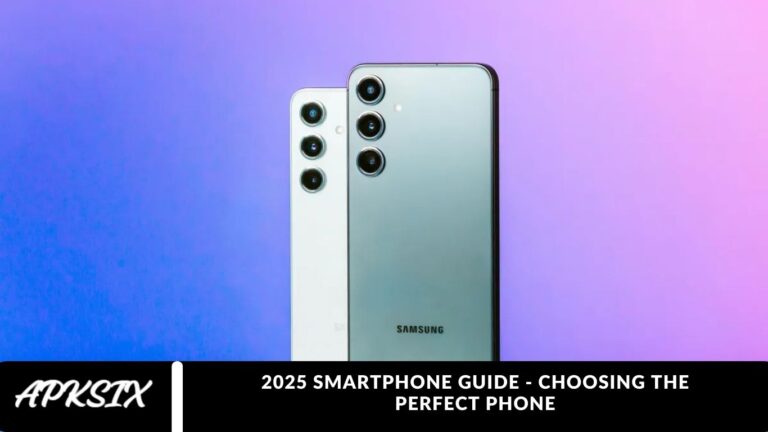If you’re planning to buy a new smartphone, you’re probably asking yourself: “How do I choose the perfect phone from so many options?” Between silicon-carbon batteries, military-grade certifications, brightness nits, and 5G band support, it’s easy to feel overwhelmed.
I get it I’ve been there too. The good news? Choosing the right smartphone doesn’t have to be confusing. In this guide, I’ll break down everything you need to know in 2025 to pick the best phone for your needs in a simple, fun, and practical way. Let’s dive in!
First of all: Who are you?
Before buying a smartphone, it’s essential to understand how you actually use your phone. To make it easier, I’ve divided users into three categories:
Balanced User:
If you primarily make calls, scroll through social media, and watch movies on Netflix, you fall into this category. You don’t need anything overly powerful your focus should be on a smooth user interface (UI) and a high-quality display. Good speakers are a bonus. Ideal budget: ₹15,000–₹25,000. No need to overspend; phones in this range offer excellent performance without breaking the bank.
Mid-Level User:
If you enjoy making calls, using social media, streaming, and occasionally gaming such as an hour of PUBG or Call of Duty you need a phone that handles both entertainment and light gaming smoothly. A budget of around ₹25,000 is perfect. Phones in this range can manage gaming without requiring the top-of-the-line processor.
Heavy User:
If your phone usage is intensive frequent calls, heavy camera use, and serious gaming you need a high-performance device. Prioritize top processors, ample storage, and excellent battery life. Budget: at least ₹40,000. Investing here ensures your phone stays powerful and reliable for years.
Now that you know which category you belong to, let’s move on to the next step: exploring the key factors to consider when choosing your perfect smartphone in 2025.
Ignore these things now!
In 2025, some aspects of smartphones that once required careful attention have become less critical. Here’s what you don’t need to stress about:
5G Bands and Network:
Most modern phones now offer excellent network and calling performance. Some devices, like the Google Pixel, may occasionally experience network issues. If you use Airtel or Vi instead of Jio, avoid phones with the Snapdragon 4s2 processor (e.g., Redmi A4 or Poco C75). Otherwise, 5G connectivity across India is strong, and call issues are rarely the phone’s fault.
Security:
You don’t need to worry excessively about hardware-level security. Realistically, much of your data is already circulating online. Instead, focus on digital awareness never share your UPI PIN or passwords with anyone. Security starts with smart habits, not just hardware features.
Bloatware:
Extra pre-installed apps aren’t a major concern. You can uninstall most apps in just a few minutes. The real problem is pop-up ads in the UI or apps that cannot be removed if a phone has these issues, it’s best to skip it. Thankfully, such problematic phones are increasingly rare in 2025.
User Interface (UI)
The user interface (UI) plays a major role in shaping your smartphone experience. Here’s a quick overview of the most popular UIs in 2025:
ColorOS (Oppo, OnePlus, Realme):
Offers a smooth experience, although budget models may lack animations, making them feel somewhat plain. Updates are generally reliable, but Realme devices may occasionally experience minor update delays.
Nothing OS:
Clean, intuitive, and timely updates make it a pleasure to use. Initial bugs may appear, and the feature set is slightly limited, but overall, it’s a fun and modern interface.
Funtouch OS (Vivo):
Visually older, but updates are consistent. For example, the Vivo T1 4G from 2022 still receives monthly updates in 2025, ensuring stability.
HyperOS (Xiaomi):
Excellent animations and smooth performance, though updates are slower in India compared to China or Europe.
One UI (Samsung):
Flagship phones shine with One UI, offering a polished experience. On budget devices, it can feel heavy, but it works fine for basic users or older adults.
Motorola UI:
Has improved significantly, offering useful features, but the update cycle still needs optimization.
XOS (Infinix):
Packed with features, often resembling Apple’s style in iOS 15, but updates are slower compared to other UIs.
Pro Tip: Focus on 2–3 UIs that match your budget and needs. Ignoring the rest will help you choose a phone that feels just right for you.
Performance
In 2025, some brands are marketing older processors (even from 2022) as “AI-powered”, and many buyers are impressed. Don’t fall for this hype focus on real performance. Here’s how to make an informed choice:
Processor:
Most modern processors deliver solid performance, except for a few, such as the FS Zen2. Be cautious if a seller is aggressively pushing a phone you might just be paying for their higher commission.
- Budget phones from Samsung, Oppo, and Vivo often have slightly weaker processors compared to competitors.
- Vivo’s T-series, like the T3 Ultra, can surprise you with excellent performance even on a budget.
Storage:
Performance isn’t just about the processor storage type matters too.
- Phones below ₹30,000 generally come with UFS 2.2, which is sufficient for smooth performance.
- Some models from Realme, Lava, and Vivo offer UFS 3.1, which enables faster loading of apps and games.
- Phones above ₹30,000 typically feature UFS 3.1 or 4.0, giving a noticeable boost in speed and responsiveness.
Pro Tip: For top-tier performance in your budget, consider iQOO phones in most cases, they deliver an excellent experience. Poco and Realme GT series are also reliable options for smooth gaming and multitasking.
Battery: Stop worrying, have fun
Most smartphone brands, except Samsung, Google, Apple, and Nothing, are using silicon-carbon batteries, which offer higher capacity in a smaller space. Many phones now come with 6,000–7,000 mAh batteries, effectively eliminating battery anxiety.
Pro Tip: Avoid charging your phone to 100%. Most modern smartphones offer a limited charging option stop at 80–85% to preserve battery health and ensure longer lifespan.
Display, speakers, and in-hand feel.
Before making a purchase, it’s important to experience the phone in person. Ask yourself:
- How does the phone feel in your hand?
- Are the display colors vibrant and punchy?
- Do the speakers deliver satisfying bass?
These details are often missed in online reviews. Take 1 hour to test your 2–4 shortlisted phones offline this small effort ensures a smooth smartphone experience for the next 3–4 years.
Avoid gimmicks!
When visiting offline stores, you’ll notice many marketing claims. Be cautious and don’t let them dictate your choice:
- Military-Grade Certification: While it sounds impressive, it doesn’t guarantee that your phone won’t break. And if it does, the warranty won’t cover it.
- TUV SUD Fluent Rating: Claims like “smooth performance for 36 months” are mostly marketing. No real-life guarantee exists.
- IP Rating (Waterproofing): A water-resistance rating doesn’t mean the phone can survive full immersion. Damage caused by water is typically not covered under warranty.
These features are nice bonuses, but don’t base your decision solely on them. Focus on your actual usage and needs for the best long-term experience.
Frequently Asked Questions
How do I choose the best smartphone in 2025?
Focus on your usage type balanced, mid-level, or heavy user then prioritize UI, processor, storage, battery, and camera performance within your budget.
Are 2025 smartphones with silicon-carbon batteries better?
Yes. Silicon-carbon batteries provide higher capacity in a smaller space, offering longer battery life without increasing phone size.
Do I need to worry about 5G bands when buying a phone?
Not really. Most modern phones support 5G effectively. Check compatibility only if you use Airtel or Vi outside Jio’s coverage area.
Which smartphone UIs are best in 2025?
Popular and smooth UIs include Nothing OS, One UI (Samsung), ColorOS (Oppo/Realme/OnePlus), Funtouch OS (Vivo), HyperOS (Xiaomi), Motorola UI, and XOS (Infinix). Pick 2–3 that match your needs.
Is a higher processor always necessary?
Not always. Most phones handle everyday tasks smoothly. Choose higher processors only if you’re a heavy user or gamer.
How important is storage type in 2025 smartphones?
Storage affects app and game loading speed. Phones with UFS 3.1 or 4.0 are faster. Budget phones typically feature UFS 2.2, which remains sufficient for most users.
Should I charge my phone to 100%?
No. Stop charging at 80–85% to maintain battery health. Most phones now have limited charging options.
Concusion
Buying a smartphone in 2025 doesn’t have to be overwhelming. By understanding your usage type balanced, mid-level, or heavy you can narrow down your options and focus on the features that matter most to you. Pay attention to UI, processor, storage, battery, display, and camera performance, and don’t get swayed by marketing gimmicks like military-grade certifications or IP ratings.

